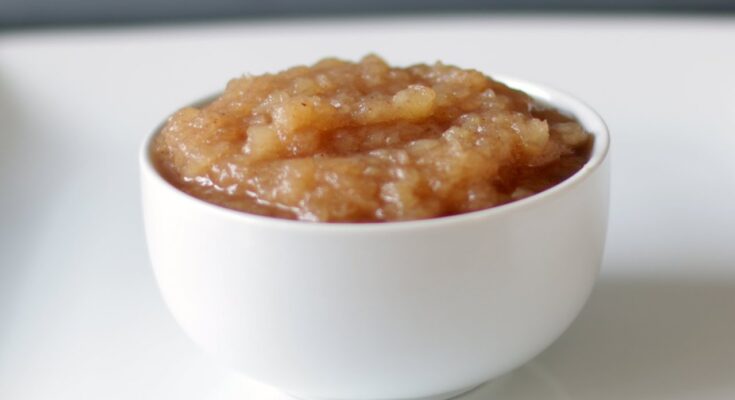Applesauce Recipe: Homemade applesauce is a simple yet delicious treat that everyone loves. Whether you’re whipping it up for a snack, using it as a side dish, or incorporating it into baked goods, applesauce is versatile and incredibly easy to make. But why settle for store-bought versions when you can create your own? With just a few fresh ingredients and some basic tools, you can enjoy a batch of applesauce that’s perfectly tailored to your taste.
In this guide, we’ll walk you through everything you need to know about making applesauce from scratch, including tips for choosing apples, adding flavors, and storing it for later use.
Ingredients for Applesauce
Making applesauce requires only a few simple ingredients. Here’s what you’ll need:
Core Ingredients:
- 4–5 large apples (about 2 pounds).
- ½ cup water or apple juice (for cooking).
- 1–2 tablespoons of sugar or honey (optional).
Optional Ingredients for Flavor Variations:
- 1 teaspoon ground cinnamon.
- A pinch of nutmeg.
- ½ teaspoon vanilla extract.
- A squeeze of fresh lemon juice.
These optional ingredients let you customize the flavor to suit your preferences. Want a spiced version? Add cinnamon and nutmeg. Prefer a fresher taste? A hint of lemon will do the trick.
Choosing the Right Apples
The type of apple you choose will significantly impact the taste and texture of your applesauce.
Best Apple Varieties:
- Sweet varieties like Fuji, Gala, or Honeycrisp work well for naturally sweet applesauce.
- Tart varieties like Granny Smith add a tangy kick.
- For the best flavor, mix sweet and tart apples.
Tips for Selection:
- Look for apples that are firm and free from blemishes.
- Choose organic apples if possible, especially if you plan to leave the skins on.
Mixing apple types creates a balanced flavor profile, ensuring your applesauce isn’t too sweet or too sour.
Tools You’ll Need
You don’t need fancy equipment to make applesauce, but having the right tools can make the process smoother.
Essential Tools:
- A sharp knife for peeling and slicing.
- A cutting board.
- A large pot or slow cooker.
Optional Tools:
- An immersion blender or food processor for a smoother texture.
- A food mill for removing skins and seeds after cooking.
These tools ensure that your applesauce-making journey is efficient and enjoyable.
Preparing the Apples
Preparation is key to great applesauce. Follow these steps:
- Wash the Apples: Rinse your apples under cool running water to remove any dirt or pesticides.
- Peel and Core: Use a peeler to remove the skins if you prefer smoother applesauce. Then, cut the apples into quarters and remove the cores. If you like a rustic texture, you can skip peeling altogether.
- Slice the Apples: Chop the apples into small, even pieces. This ensures they cook evenly and saves time during blending.
Pro Tip: If you’re short on time, an apple slicer can speed up the coring and slicing process.
Cooking the Apples
Cooking the apples is where the magic happens. Here are two popular methods:
Stovetop Method:
- Place your apple slices in a large pot.
- Add ½ cup of water or apple juice.
- Bring the mixture to a boil, then reduce the heat to a simmer.
- Cover and cook for 15–20 minutes, stirring occasionally, until the apples are soft and mushy.
Slow Cooker Method:
- Add apples and water to your slow cooker.
- Set it to low and cook for 4–6 hours or until the apples are very soft.
- Stir occasionally to prevent sticking.
Both methods work beautifully, so choose the one that fits your schedule.
Adding Flavor to Applesauce
Once your apples are cooked and soft, it’s time to elevate the flavor. While plain applesauce is delightful, adding a few extra ingredients can make it extraordinary.
Sweeteners: How Much to Use?
- Taste your applesauce before adding sugar or honey. Depending on the type of apples you used, it might not need any extra sweetness.
- If you want a sweeter applesauce, add sugar, honey, or maple syrup in small increments (1 tablespoon at a time) and taste as you go.
Spices for Extra Flavor
- Cinnamon: The classic choice for applesauce. Start with 1 teaspoon and adjust to your preference.
- Nutmeg and Cloves: Add a pinch for a warm, spiced flavor.
- Ginger: A small dash of ground ginger can give your applesauce a zingy twist.
Creative Twists
- Add a splash of vanilla extract for a creamy aroma.
- Mix in a bit of lemon juice for a bright, fresh finish.
- Experiment with other fruits like a handful of berries or chopped pears to create unique blends.
The beauty of making your own applesauce is the ability to customize it however you like. Get creative and make it your signature recipe!
Blending or Mashing the Applesauce
Now that your apples are cooked and flavored, it’s time to decide on the texture. Do you want chunky applesauce or a smooth, velvety puree?
Chunky Applesauce
- Use a potato masher to mash the apples directly in the pot.
- Stir well to combine the pieces and flavors.
- Perfect for those who enjoy a rustic, homemade feel.
Smooth Applesauce
- Use an immersion blender for easy, mess-free blending in the pot.
- Alternatively, transfer the apples to a food processor or blender and puree until smooth.
- For ultra-smooth applesauce, push it through a fine-mesh sieve or food mill.
Tips for Perfect Texture
- If the applesauce is too thick, add a splash of water or apple juice to thin it out.
- For added creaminess, stir in a dollop of unsweetened yogurt or cream after blending.
Storing Homemade Applesauce
One of the best parts about making applesauce is having it on hand for future use. Proper storage will ensure it stays fresh and delicious.
Refrigeration
- Allow the applesauce to cool completely before transferring it to an airtight container.
- Store in the refrigerator for up to 7–10 days.
Freezing
- Divide the applesauce into freezer-safe containers or resealable bags.
- Leave some room at the top for expansion during freezing.
- Frozen applesauce lasts up to 6 months. Thaw overnight in the fridge before use.
Canning for Long-Term Storage
- Sterilize jars and lids before filling them with hot applesauce.
- Process the jars in a boiling water bath for 20 minutes.
- Canned applesauce can be stored in a pantry for up to 1 year.
With these storage tips, you can enjoy your homemade applesauce whenever the craving strikes.
Creative Uses for Applesauce
Homemade applesauce isn’t just for eating by the spoonful. Its versatility makes it a kitchen superstar. Here are some creative ways to use it:
Baking Substitute:
- Replace oil or butter with applesauce in muffins, cakes, or brownies for a healthier twist.
- Swap 1 cup of oil with ¾ cup of applesauce for moist, flavorful results.
Toppings and Sides:
- Serve it warm over pancakes, waffles, or French toast.
- Use it as a side dish for pork chops or roast chicken.
Healthy Snack Ideas:
- Pair it with granola and yogurt for a parfait.
- Spread it on toast with a sprinkle of cinnamon for a quick breakfast.
These ideas ensure your applesauce never goes to waste.
Common Mistakes to Avoid
Homemade applesauce is foolproof if you avoid these common pitfalls:
Overcooking or Burning: Keep an eye on the pot, especially if you’re using the stovetop method. Stir occasionally to prevent sticking.
Not Balancing Flavors: Taste and adjust sweetness and spices as you go. Remember, less is more—you can always add more later.
Improper Storage: Don’t skip cooling the applesauce before storing it. Warm applesauce in a sealed container can lead to condensation and spoilage.
By avoiding these mistakes, you’ll consistently create perfect applesauce.
Customizing Your Applesauce
Once you’ve mastered the basics, it’s time to experiment with unique variations. Here are some fun ideas:
Sugar-Free Applesauce
- Skip the sweeteners entirely or use natural alternatives like stevia.
- Use naturally sweet apple varieties like Fuji or Gala for the best results.
Spicy Applesauce
- Add cayenne pepper or chili flakes for a spicy-sweet combo.
- Perfect for adventurous palates and as a side dish for savory meals.
Mixed Fruit Applesauce
- Add fresh or frozen fruits like pears, peaches, or strawberries.
- These additions create a colorful and flavorful twist.
The possibilities are endless, so don’t be afraid to think outside the box!
Troubleshooting Your Applesauce
Even seasoned cooks encounter issues. Here’s how to fix common applesauce problems:
Watery Applesauce:
- Simmer the sauce uncovered to evaporate excess liquid.
- Add a teaspoon of cornstarch dissolved in water if you’re short on time.
Too Sweet or Bland:
- Stir in a splash of lemon juice to cut the sweetness.
- Adjust spices like cinnamon or nutmeg to enhance the flavor.
Uneven Texture:
- Blend in small batches for a more consistent texture.
- Add water if the sauce is too thick after blending.
Nutritional Benefits of Applesauce
Homemade applesauce is not just tasty—it’s packed with nutrients.
- Low in Calories: One cup of unsweetened applesauce has about 100 calories, making it a guilt-free snack.
- Rich in Fiber: Applesauce supports healthy digestion and keeps you feeling full longer.
- Vitamins and Antioxidants: It’s a good source of vitamin C and other antioxidants that support overall health.
For those watching their diet or looking for healthy snacks for kids, applesauce is an excellent choice.
FAQs about Applesauce Recipe
1. What ingredients do I need to make applesauce?
To make applesauce, you’ll typically need fresh apples, water, and a sweetener like sugar or honey. You can also add cinnamon or other spices for extra flavor.
2. What type of apples is best for applesauce?
Soft and sweet apples like Fuji, Gala, or McIntosh work great for applesauce. For a tangier flavor, try adding Granny Smith apples.
3. How do I make applesauce at home?
Peel, core, and chop the apples. Cook them in a pot with water until soft, then mash or blend them to your desired consistency. Add sweetener or spices as needed.
4. Can I make applesauce without sugar?
Yes, you can skip the sugar and let the natural sweetness of the apples shine. Alternatively, use a sugar substitute like stevia or maple syrup.
5. How do I store homemade applesauce?
Homemade applesauce can be stored in an airtight container in the refrigerator for up to a week. For longer storage, freeze it in portion-sized containers.
6. Is applesauce healthy?
Yes, applesauce is a healthy snack, especially when made without added sugar. It’s a great source of fiber and vitamins, making it perfect for kids and adults alike.
7. Can I use applesauce in baking?
Absolutely! Applesauce is often used as a substitute for oil or butter in baking recipes to reduce fat content while adding moisture and flavor.
8. How can I customize my applesauce?
You can add ingredients like vanilla extract, nutmeg, or even berries to create unique flavors. Experiment to find your favorite combination!
Conclusion
Making homemade applesauce is a rewarding experience that’s as simple as it is delicious. From choosing the perfect apples to customizing flavors and textures, you have full control over the process. Whether you’re making it for snacks, baking, or as a side dish, this versatile recipe is sure to become a staple in your kitchen.
So, grab some fresh apples and give it a try—you’ll never go back to store-bought again!



